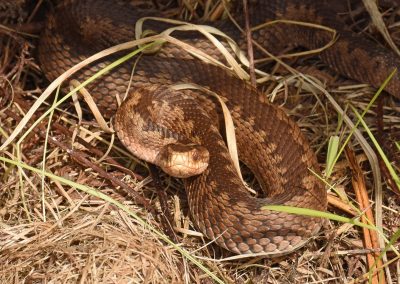Here’s a fascinating blog by Helen McKay about the ‘Dunrobin 2’ Pictish carved stone found near Golspie (over the grave of a woman who died around 660AD) and now on display at Dunrobin Castle Museum.
In her blog, Helen looks at the snake symbol on the stone and highlights the relationship between goddesses and snakes in Roman and Celtic mythology. So who was the woman whose grave was marked by this stone? Pictish princess, Pictish priestess, someone with links to a Pictish goddess? We will probably never know, but this blog is certainly food for thought and may make you think differently about other Pictish stones with similar carvings.
Helen is a computational linguist, now retired and enjoying nature and thinking about all things Pictish and the Coligny Calendar. The Dunrobin 2 stone is just one of an amazing collection of Pictish stones at Dunrobin Castle Museum – definitely must-sees on the Highland Pictish Trail.
Following the Pictish trail is like having a personal guide to the most beautiful spots in Scotland. At Dunrobin, where two late CI stones were found, the wide stretch of beach has seen a long time of Pictish and Norse settlement, a perfect place to pull their boats to shore.
And then, there is the amazing secret den behind Dunrobin castle, full of trees that really shouldn’t be found this far north. A place below the land surface, safe from the wind and cold, humid, secret, out of this world. A place of magic, with a deep pool at its far end. (Please note that if you click on the images, they will open in a separate window allowing you to take a closer look).
One Dunrobin stone was found over a large rectangular cairn of a woman who died around 660 AD. It was just above the line of the beach, with the den running behind it. She must surely have been loved given the care spent on her grave. Her body was laid out in a cist, a box made of sandstone slabs, then the grave was covered with pure clean sand and a layer of pebbles. Finally, the whole cairn was surrounded by kerb stones, and the symbol stone of smooth pink sandstone was carved and placed on top.
But the stone is unusual as it doesn’t have a large area at the bottom which can be dug into the earth to support the stone upright, like most symbol stones do. So we don’t know whether this symbol stone was laid flat on top of the grave, or whether it may have been part of some wooden structure above it. And there are a few other stones like this around, so were the Picts sometimes making symbol stones as part of a shrine?
To find a single symbol stone marking a Pictish grave is exceptional. Most stones aren’t in a burial context at all, although some seem to mark a burial ground. And to be able to date one like this from the burial is pretty much unique.
It’s interesting that there is a snake/Zrod symbol on the grave of this ‘Pictish princess’ (as she has been dubbed), as we have also found snake bracelets which, from their smaller size, were made for women. And the snake symbol here has the typical zigzag of the Scottish adder – the Picts were really good at depicting their animals in a very realistic way, and in a very beautiful way.
But what did the snake signify to the Picts? We don’t really know, all we can do is put together the answer bit by bit as we work on figuring it out.
Female deities and saints are shown with snakes. Sirona, a star or sun goddess of healing, is depicted in Gaul with a snake wrapped around her arm. From her epithets, the snake is a a symbol of healing and fertility. A good reliable site to read about her is here https://earthandstarryheaven.com/2015/03/08/sirona-healer-goddess/
Brigid too is associated with a serpent in the Carmina Gadelica : Today is the day of Bride, the serpent will come out of her mound.
What does the other symbol represent? This symbol is found on four other stones, but it is usually just two simple crescents back to back. But the Dunrobin example is just pure magic. It’s complex, exquisite, I just love it. What my imagination sees is the face of an adder seen front on, staring directly at me. Am I seeing things? Or did the Picts take the opportunity to turn an otherwise plain symbol into something also a snake? What do you think?
As an Ozzie, I’m used to watching where I place my feet in the bush with snakes all round us, so when I was first in Scotland I was tramping over the hills with gay abandon, thinking here finally there was no threat. Until one day in the far north of the Highlands, I said to a local friend how wonderful it was to walk free. He made no comment, except to invite me for a small walk up the hill – where he showed me a nest of young adders, all enjoying the summer sunshine. Thanks mate! The dream was over.
But I still love these Pictish symbols, including the snake. I’ll just walk a bit more carefully.





